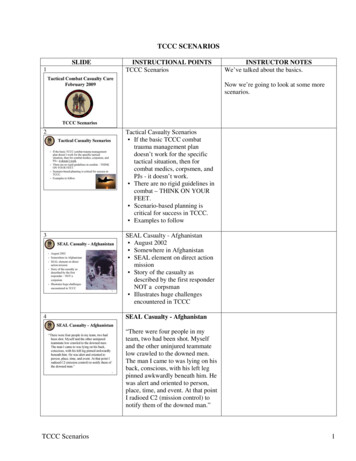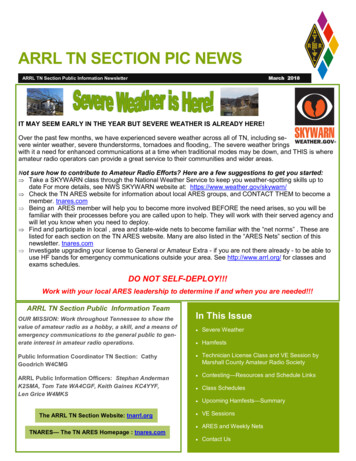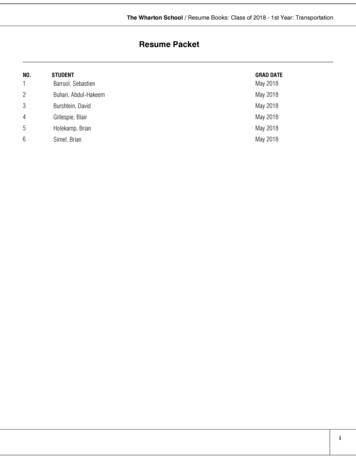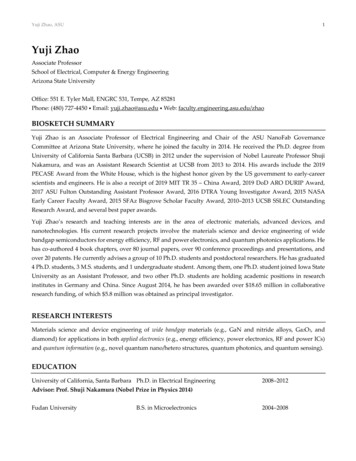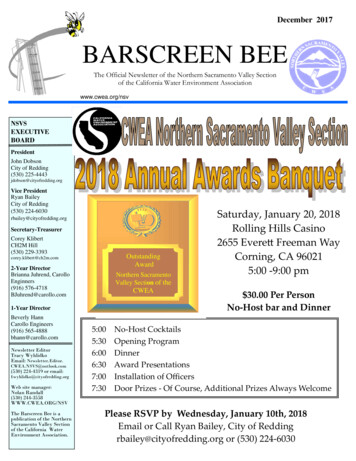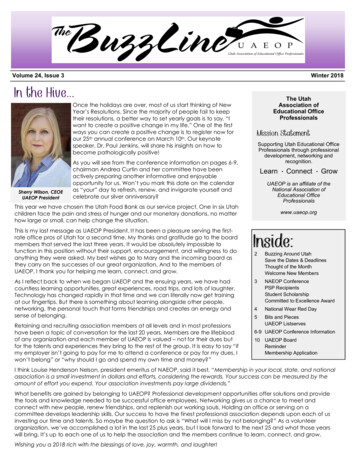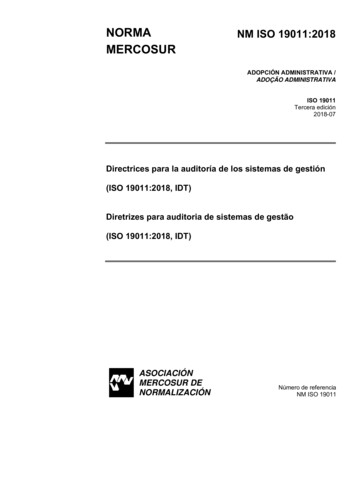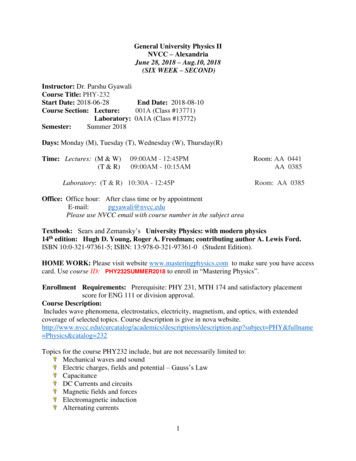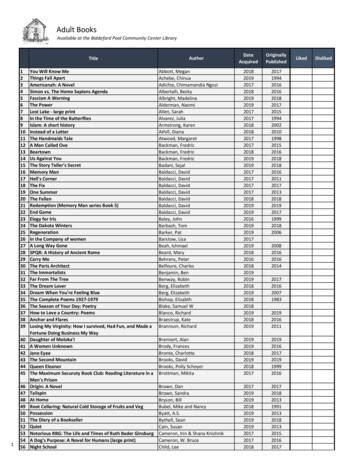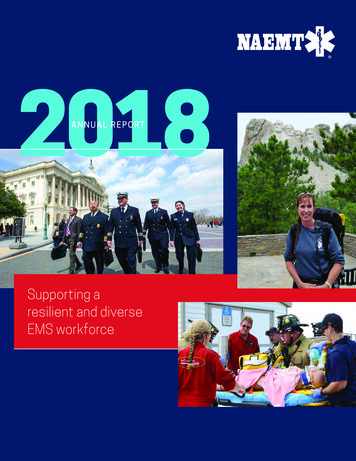
Transcription
2018ANNUAL REPORTSupporting aresilient and diverseEMS workforce
Our Mission, Values & VisionThe mission of the National Association of Emergency Medical Technicians (NAEMT)is to represent and serve emergency and mobile healthcare practitioners includingemergency medical technicians, advanced emergency medical technicians,emergency medical responders, paramedics, advanced practice paramedics, criticalcare paramedics, flight paramedics, community paramedics, and mobile integratedhealthcare practitioners. We believe that EMS is a distinct and essential service to the public and a fundamentalcomponent of our nation’s emergency response and healthcare systems. We believe that all patients deserve high quality and safe medical care delivered byqualified EMS professionals. We believe that all EMS professionals deserve a safe, healthy and respectful workenvironment. We believe that EMS is uniquely positioned to support our nation’s healthcaretransformation by assessing, treating and navigating patients to the right care, in theright place, at the right time. We believe that each community should determine the EMS delivery model(s) thatbest meets their needs and resources. We believe that collaboration within the EMS profession and within the largerhealthcare community is essential to addressing the key challenges in delivering highquality EMS. We believe that all EMS professionals deserve adequate and equitable compensation. We believe that professional education, national education standards and researchare essential to the consistent delivery of high quality, evidence-based EMS. We shall represent the views and concerns of all EMS professionals regardless ofdelivery model. We shall conduct all NAEMT business with integrity and transparency, and adhere tothe ethical standards of our profession.NAEMT will measurably advance the EMS profession through activities that: Develop tools for EMS agencies and professionals to improve patient care and outcomes. improve the work environment in which EMS is practiced. Increase access to quality education for all EMS agency personnel. Help develop an infrastructure to implement EMS quality improvement. Support evidence based EMS research.23From the President42018 Leadership5Corporate Partners andAffiliates6NAEMT Advocacy62018 Advocacy Victories7Advocating for PaymentReform to Advance EMS8EMS On The Hill Day10More Advocacy Eventsand Initiatives11Positions, Letters andComments12Initiatives: Supporting theEMS 3.0 Transformation13Initiatives: PromotingWellness and Resilience inEMS14Initiatives: Supporting EMSPreparedness15New Initiatives: SupportingExcellence in Clinical Care16Education: Strong GrowthAcross the U.S. andInternationally18New in 201819Trauma Education20Medical Education21Operational Education22Membership23Member Spotlights &Scholarships24NAEMT Annual MeetingEvents25EMS Awards26Member Benefits27Financial 2368NAEMT.ORG
From the PresidentAs our profession’s largest and most inclusive membershiporganization, NAEMT strives to ensure that the EMS workforcehas the resources, training, education and support needed tocare for members of the community in their time of greatestneed. In 2018, NAEMT made substantial progress in severalimportant areas, including: Advancing payment reform to ensure that EMS iscompensated for providing healthcare services, in additionto transportation. Supporting the transformation of EMS from prehospitalemergent medical response to a system of prehospital andout-of-hospital emergent, urgent and preventative carethat is fully integrated in a community’s healthcare system. Enhancing preparedness, to ensure that our EMSworkforce has the resources and training to respondto natural and man-made disasters and mass casualtyincidents.Celebrating Advocacy WinsAt the federal level, NAEMT’s efforts to educate congressionalleaders about the vital role of EMS and our collaboration withother national organizations was instrumental in the passageof several important measures, including: A five-year extension of the Medicare ambulance add-onpayments, which are crucial to the financial viability of ournation’s EMS agencies. The Supporting and Improving Rural EMS Needs (SIREN)Act, to provide grants for EMS agencies in rural areas torecruit, train and equip personnel. The Stop, Observe, Ask and Respond (SOAR) Act, to trainEMS and other healthcare providers to respond to thevictims of human trafficking.We also launched NAEMT’s first EMS Political ActionCommittee to support our advocacy efforts. PAC funds will beused to make contributions to candidates for federal electiveoffice who champion our profession and our patients.Expansion of NAEMT Education Programs2018 also saw tremendous growth in our education programsin the United States and abroad. Over 114,000 students tookNAEMT courses in 2018, an increase of nearly 17% fromthe prior year. We are proud to offer the highest qualityEMS continuing education programs available anywhere inthe world. Our teams of authors include EMS physicians,practitioners, educators and other subject matter expertswho work together to create courses that are evidence-based,up-to-date, field-tested and provide an engaging, dynamiclearning experience – in short, courses that help prepare EMSpractitioners for the countless types of scenarios they mayface on any given shift. An education highlight in 2018 waspublishing the 9th edition of Prehospital Trauma Life Support(PHTLS), and hosting the largest-ever PHTLS instructor updatein Nashville at EMS World Expo.Our Members Make Us StrongWith members in every U.S. state, the District of Columbia,Puerto Rico and in many countries across the globe workingfor all types of EMS delivery models, we are proud to say thatNAEMT members make up the most diverse, dynamic andaccomplished group of EMS professionals, anywhere in theworld. In our new Member Spotlight feature in NAEMT News,we highlighted four distinguished NAEMT members – MargaretFarrell, a volunteer EMT for nearly 30 years; Andrew Neil, anEMS educator and EMS chief for Nashville Fire Department whoearned his bachelor’s degree in his 40s; Kevin Todd, a paramedicwho ran for city council; and Debbie Von Seggern-Johnson, anEMS/trauma coordinator whose interest in EMS was sparkedafter she nearly lost her infant son to a choking accident.By providing the best care for each patient, these individualsare examples of the thousands of NAEMT members across thecountry and the world who steadfastly serve their patients andcommunities. We are thankful for each one of our members.You make it possible for NAEMT to continue to advocate onbehalf of our workforce and to advance the EMS profession.We are extremely grateful and appreciative of your support.Dennis RoweNAEMT President 2017-2018, EMT-PNAEMT.ORG800-346-23683
2018LeadershipThe NAEMT Board of Directors is madeup of volunteers elected by our membersto lead the association in carrying out itsmission. Board members generouslygive their time and expertise to setNAEMT priorities and contribute toNAEMT initiatives and projects.OfficersBoard of DirectorsDennis Rowe, PresidentMatt Zavadsky, President-electBruce Evans, SecretaryChad McIntyre, TreasurerConrad T. “Chuck” Kearns, ImmediatePast PresidentSean Britton, Region I DirectorRobert Luckritz, Region I DirectorSusan Bailey, Region II DirectorCory Richter, Region II DirectorJason Scheiderer, Region III DirectorChris Way, Region III DirectorTerry David, Region IV DirectorTroy Tuke, Region IV DirectorCharlene Cobb, At-Large DirectorJonathan Washko, At-Large DirectorCraig Manifold, DO, Medical DirectorIIIIIVIICommittees4The Board of Directors has established 14committees comprised of more than 140volunteer members who work on importantNAEMT projects and initiatives. Committeesare involved with our association’sgovernance and administration, developand teach our education programs, andlend their expertise to address specificissues that impact our profession. NAEMTrecognizes and appreciates their time,effort and support.Candidacy and ElectionsChair: Dennis WilhamFinanceChair: Chad McIntyreEducationChair: Rick EllisLeadership DevelopmentChair: Chuck KearnsEMS 3.0Chair: Matt ZavadskyMembershipChair: Chris WayEMS Disaster PreparednessChair: Jim JudgeMilitary RelationsChair: Dr. Craig ManifoldAdvocacyChair: Terry DavidEMS WorkforceChair: Mark (Ronald) HeathNAEMT EMS PAC Steering CommitteeChair: Bruce EvansAdvanced Medical Life SupportChair: Jeff MesseroleEmergency Pediatric CareChair: Shannon WatsonPrehospital Trauma CommitteeChair: Dr. Alex Eastman800-346-2368NAEMT.ORG
Corporate Partners and AffiliatesNAEMT’s Corporate Partners help us serve our membersand achieve our goals by providing financial and otherforms of support to the association. We are grateful for theircontributions to our association and the EMS profession!EliteAnnualColumbia Southern UniversityEMS World5.11 Tactical, Inc.Abaris GroupCoalition Against BiggerTrucksCandor InsuranceDigitech ComputersGaumardGold CrossInternational Police MountainBike AssociationLogis SolutionsLuna InnovationsMedEx BillingMedic-CEMercury MedicalMobile Health Resources EMSSTNascoNational EMS MuseumFoundationNonin MedicalNorth American RescuePage Wolfberg & WirthPanakeiaPelvic BinderPhilips LifelinePhysio-ControlPlatinum Educational GroupPulsaraSAM MedicalSCAD AllianceSimulaids Lifeform by NASCOHealthcareSolutions GroupS.T.A.T. Medical DevicesTEMS SolutionTrauma Center Association ofAmerica (TCAA)Z-MedicaPremieriSimulateJEMSJones and Bartlett LearningPublic Safety GroupNational Registry ofEmergency MedicalTechnicians (NREMT)DiamondEMS1MarkelPlatinumFirstNetJournal of Special OperationsMedicineMedtronicStrykerGoldH&H Medical ProductsOnStarSilverAmerican College ofEmergency PhysiciansBound Tree MedicalBraun IndustriesCAE HealthcareFitch & AssociatesThe Morgan Lens /MorTan Inc.BronzeAbbottAmerican Heart AssociationAcademi Training CentersProMed NetworkSkedcoSpecial Operations MedicalAssociation (SOMA)NAEMT.ORG800-346-2368Affiliation is a formal relationship between NAEMT and anEMS membership association to help further our sharedpurpose and goals. Affiliated associations are representedon NAEMT’s Affiliate Advisory Council to advise the NAEMTBoard of Directors on issues and concerns within EMS.Affiliated AssociationsAlabama EMS AssociationArkansas EMT AssociationAssociation of EMTs IndiaAssociation of Texas EMS ProfessionalsDelaware State EMS AssociationEMS Association of ColoradoFlorida Ambulance AssociationFlorida EMS AssociationGeorgia Association of EMSIllinois EMT AssociationIndiana EMS AssociationIowa EMS AssociationJapanese Paramedics AssociationKansas EMS AssociationKansas EMT AssociationLouisiana Association of Nationally Registered EMTsMichigan EMS Practitioners AssociationMinnesota Ambulance AssociationMississippi EMT AssociationMissouri EMS AssociationNational Collegiate EMS FoundationNational EMS Management AssociationNebraska EMS AssociationNew Hampshire Association of EMTsNew Mexico EMT AssociationNew York State Volunteer Ambulance & Rescue AssociationNorth Dakota EMS AssociationOhio EMS AssociationOhio EMS Chiefs AssociationOklahoma EMT AssociationOregon EMS AssociationParamedic Association of CanadaPennsylvania Emergency Health Services CouncilProfessional Ambulance Association of WisconsinProfessional Emergency Responders Society of IllinoisSavvik Buying GroupSouth Carolina EMS AssociationSouth Dakota EMS AssociationTennessee EMS Educators AssociationTennessee Ambulance Service AssociationUtah Association of Emergency Medical TechniciansVermont Ambulance AssociationVirginia Association of EMS PractitionersWisconsin EMS Association5
NAEMT AdvocacyNAEMT represents our members on key issues that impact ourability to provide quality patient care, including the workingconditions, pay, safety and training of the EMS workforce.Through advocacy, NAEMT works to ensure that EMS has theresources needed to provide optimal patient care, and that theEMS perspective is incorporated into the policies, plans andprograms of our government.Thank you to all NAEMT members who emailed or called theirlegislators to support our 2018 advocacy campaigns, and a veryspecial thank you to NAEMT’s advocacy coordinators and themembers of NAEMT’s Advocacy Committee! These dedicatedNAEMT members educate and inform elected officials, theirEMS colleagues, the public and other stakeholders aboutthe value of EMS and the need for legislation thatsupports EMS in fulfilling its mission.2018 Advocacy VictoriesNAEMT collaborated with other national EMS organizations to accomplish multiple legislative victories in 2018, including passage of:A Five-Year Extension ofMedicare Ambulance Addon Payments to extend theMedicare bonus payments of2% urban, 3% rural, and 22.6%super rural for five years andbegin the process of cost datacollection.6The Opioid Crisis ResponseAct, which includes grants andother measures to help firstresponders and EMS agenciespurchase personal protectiveequipment to protect theirworkforce from exposure topotent drugs such as fentanyl,and to buy overdose reversaldrugs (such as naloxone) tosave lives.The Stop, Observe, Askand Respond (SOAR) toHealth and WellnessAct, which directs the U.S.Department of Health andHuman Services (DHHS) toestablish a program to trainsocial services and healthcareproviders – including EMS – toidentify, treat and respondappropriately to victims ofhuman trafficking.The Supporting andImproving Rural EMSNeeds (SIREN) Act, whichreauthorizes a federal grantprogram to recruit, train andequip EMS practitioners inrural communities. The SIRENAct was passed as part of theAgriculture Improvement Actof 2018 (the Farm Bill). Workcontinues to ensure thatCongress appropriates fundsto implement SIREN.800-346-2368NAEMT.ORG
Advocating for Payment Reformto Advance EMSIn 1965, the federal government madeambulance transportation a coveredbenefit for Medicare and Medicaidbeneficiaries. As a result, a large shareof EMS non-tax revenue is derived fromtransporting patients to the hospital.Yet, limiting reimbursement totransportation has led to the undervaluingof the medical care provided by EMTs andparamedics – whether saving the life of atrauma victim, resuscitating and stabilizinga cardiac arrest victim, or assessing astroke patient to activate a stroke team.In all of those cases, despite the education,training, readiness and medical expertiserequired to respond, EMS is still paid onlyfor transporting the patient to the hospital.Paying EMS practitioners asmedical providersTo move EMS beyond this outdatedreimbursement model, NAEMT is workingtoward payment reform to compensateEMTs and paramedics as healthcareproviders who provide healthcareservices, in addition to transportation.The goal is to ensure that EMS is paid forthe full value of the services providedto the community. Achieving this willpave the way for more resources for ournation’s EMS agencies, higher pay for ourworkforce and an enhanced ability forEMS practitioners to provide the best andmost appropriate care for patients.Working with CMS and CongressIn early 2018, the EMS professioncelebrated when Congress passed afive-year extension of Medicare addon payments to the ambulance feeschedule for transports originating inurban, rural and super-rural areas. Inreturn for continuing the extra payments,legislators included a requirement for theU.S. Department of Health and HumanServices (DHHS) to develop an EMS costdata system to collect information oncosts, revenue and utilization of groundNAEMT.ORG800-346-2368ambulance services. The information will be used to help the Centers for Medicare andMedicaid (CMS) to determine if the ambulance fee schedule is in line with the cost ofproviding the services.NAEMT sees cost collection as an opportunity to collect data that will allow ourassociation and the EMS profession to better advocate for reimbursement that reflectsthe full value of EMS in the community. To ensure the cost collection system put intoplace is effective and reasonable, NAEMT worked closely with CMS and the RANDCorporation, which is contracted to develop the cost analysis tool, to host severalfocus groups. The focus groups sought input from all types of EMS agencies – public,private, hospital-based, urban, rural, and volunteer. Two focus groups, including one formanagers and one for EMS practitioners, were held in October 2018 at EMS World Expo.Three additional focus groups, focusing on rural/volunteer agencies and agencies thatalready participate in a cost data collection system, were held via teleconference.The connection between payment reform and EMS 3.0NAEMT has been a leading voice for the EMS 3.0 transformation, which promotespayment for all of the services EMS provides, including: urgent care for the acutely ill orinjured, chronic disease management and preventive care.In 2018, NAEMT met with CMS and the Center for Medicare & Medicaid Innovation(CMMI) to discuss how to evaluate new EMS roles such as treat-and-refer services,transport to alternate destinations, community paramedicine and 911 nurse triage.NAEMT leaders participated in four conference calls with CMS and CMMI leaders andprovided sample training programs, protocols, quality assurance processes, outcomemeasures and examples of EMS agencies that are already receiving payments for servicesother than ambulance transport to an emergency department.We are proud of the significant progress made in 2018 to advance payment reform,and we will continue to advocate for changes to payment models that will allow EMSpractitioners to be fairly compensated, adequately resourced, well prepared and fullyrecognized for their role as healthcare providers.7
EMSON THE HILL DAY“Having the opportunity to sit down with our senatorsand representatives is invaluable to the citizens we serve.37 # of states represented, plus Puerto Rico216Total # of meetings attendedwith congressional leaders and their staff2358EMSParticipantsReg Allen, CEO of CHS Mobile Integrated Healthcare, Rochester, New York”On April 11, 2018, EMS professionals from around the nation came toWashington, D.C. for EMS On The Hill Day, hosted by NAEMT. After a briefing theevening before about the year’s legislative priorities, 235 EMS professionals from37 states and Puerto Rico had a whirlwind day of meetings on Capitol Hill.Participants educated Congressional leaders and their staff about the vitalrole of EMS, shared their expertise and their experiences on the job, anddiscussed the issues of importance to our profession and our patients.As the profession’s most inclusive national advocacy event, EMS On TheHill Day encourages participation from all delivery models – public, private,fire-based, hospital-based, volunteer, for-profit, nonprofit and public utilitymodels. The event concluded with a reception, where participants relaxed,debriefed and connected with their EMS colleagues from around the country.Thank you to all who made the trip to D.C. to advocate for EMS and our patients!800-346-2368NAEMT.ORG
25 # of bills NAEMT Advocacy Committeereviewed and took a position on in 2018.EMS Advocate of the Year AwardsAs part of the EMS On The Hill Day events,NAEMT recognized three outstandingadvocates for their commitmentto educating and engaging electedofficials, their colleagues and the widerhealthcare community. Congratulationsto Andrew Jackson of Illinois, William“Mike” McMichael of Delaware, andJennifer Smith of Wisconsin.49Members of theCongressionalEMS CaucusThe caucus is a bipartisan group in the U.S.House of Representatives that promotesthe critical role of EMS in our community.NAEMT advocacy is a driving force in makingsure members of Congress are aware ofthe caucus and encouraging them to join.NAEMT.ORG800-346-23689
M O R E A D V O C A C Y E V E N T S A N D I N I T I AT I V E S10National EMS Weekon the HillNAEMT LaunchesEMS PACSupporting StateLevel AdvocacyEleven national organizations joinedforces to hold a National EMS WeekExhibit for congressional leaders and theirstaff at the U.S. House of Representatives’Rayburn Building in Washington, D.C. Heldon May 24 to coincide with EMS Week’s“Save a Life” Day, the event was organizedby NAEMT and the American College ofEmergency Physicians (ACEP). Membersof Congress and their staff were taughtcompression-only CPR and basic bleedingcontrol techniques.Through the tremendous efforts ofour member advocates, NAEMT hasmade good progress in educating ourcongressional leaders and federalagencies on the key issues that impactour ability to provide quality patient care.To support these efforts, in 2018, theNAEMT Board established the NAEMT EMSPolitical Action Committee (PAC). The PACis a separate segregated fund comprisedof voluntary contributions from NAEMT’smembers and their families. NAEMT willuse the funds to make contributions tocandidates for federal elective office.The PAC will help us to elect or re-electfederal candidates who are friends of ourprofession and the patients we serve.Laws passed by state legislatures havea significant impact on the daily practiceof EMS, from the medications EMSpractitioners are permitted to administerto legal protections against violence onthe job. To help EMS practitioners andstate EMS organizations advocate for lawsthat protect and benefit EMS and patients,NAEMT’s Board of Directors launched anew initiative to support state legislativeadvocacy. The initiative includes: Enhancements to NAEMT’s OnlineLegislative Service (OLS) that help EMSpractitioners easily track pending EMSrelated legislation in their state and inother states. An online library of sample state EMSlegislation that can be used as modelsor examples to other states. Support for state level legislation whenrequested by state EMS associations.800-346-2368NAEMT.ORG
Positions, Letters and CommentsThrough published statements, letters and comments, NAEMT provides input andcommunicates our positions on pending legislation or federal policy. In 2018, NAEMTprovided comment on many important issues. Here is a selection:Letter Regarding EmergencyMedication ShortagesFaced with ongoing shortages of essentialemergency medications, NAEMT joinedsix national EMS, fire and emergencyphysician associations in sending a letterto the U.S. Food and Drug Administration(FDA) and DHHS asking its leaders to domore to address the problem.Input on the EMS Agenda 2050With input from 22 NAEMT leadersand subject matter experts, NAEMTrecommended that the EMS Agenda 2050address numerous issues, including: The lack of adequate reimbursementfor chronic disease management andpreventive care provided by nontransport EMS personnel. A regulatory environment that restrictsEMS professionals from crossing statelines to provide care. The lack of exchange of healthinformation between EMS andhospitals for quality improvementpurposes. The lack of a consensus-based set ofkey performance indicators (KPIs) thatallow for the objective measurement ofEMS clinical performance.Letter to the Centers for Medicareand Medicaid Services on CostReportingNAEMT joined five other nationalorganizations to ask the Centers forMedicare and Medicaid Services (CMS) toadopt an EMS cost data collection processsimilar to a process in use in Californiaand several other states. The cost datasubmitted to CMS should be detailedand transparent, while avoiding puttingan unnecessary administrative burdenon the agencies that have to collect it,according to the letter sent in Decemberand signed by NAEMT, the InternationalNAEMT.ORG800-346-2368Association of Fire Chiefs (IAFC),International Association of Fire Fighters(IAFF), Metropolitan Fire Chiefs Association(Metro Chiefs) and the National VolunteerFire Council (NVFC).Comment on ASPR Mass CasualtyTriage White PaperIn a letter to the Office of the AssistantSecretary for Preparedness and Response(ASPR), NAEMT called for: more MCItriage training and medical surgeexercises, regularly scheduled jointtraining exercises/drills involving EMS andhospitals, and greater involvement of lawenforcement and volunteer fire in MCItriage training. ASPR leads the nation’smedical and public health efforts toprepare for, respond to and recover fromdisasters and public health emergencies.Position Statement on EMS inHealthcare PolicyThis position statement recommends thatEMS actively participate in developinghealthcare policy at the federal, stateand local level, and describes 10principles regarding the role of EMS, howEMS should be reimbursed, and EMSintegration with other healthcare entitiesthat should be included in healthcarepolicy.11
I N I T I AT I V E SSupporting theEMS 3.0 TransformationIn 2018, NAEMT continued our work in supporting the transformation of EMS into asystem of prehospital and out-of-hospital emergent, urgent and preventive care that isfully integrated with a community’s healthcare system. Our campaign included severalinitiatives focused on raising awareness and educating NAEMT members, electedofficials and other stakeholders about the value of mobile integrated healthcare andcommunity paramedicine (MIH-CP).Publishing the MIH-CP 2nd National SurveyMobile Integrated Healthcare andCommunity Paramedicine (MIH-CP)2nd National SurveyHow EMS is meeting community healthneeds through innovative partnerships,programs and servicesSponsored byNAEMT’s 2nd National Survey on Mobile Integrated Healthcareand Community Paramedicine (MIH-CP) explored the effortsof 129 EMS agencies in 33 states and Washington, D.C.,to launch and sustain MIH-CP programs. The reportexamined MIH-CP services, finances, partnerships, statelaws and training. Published in April, the report found thatsupport for MIH-CP within EMS and among stakeholderssuch as hospitals, home health agencies and insurers hasgrown since the 1st national survey was published in 2015.The report was distributed to NAEMT members, nationaland state level EMS organizations, members of Congressand federal agencies, and is available for download free ofcharge at naemt.org.Hosting the EMS 3.0 Transformation SummitWith the theme of “Profiles in Courage,” the EMS 3.0 Transformation Summit broughttogether leaders from EMS, healthcare and government to share their expertise andinsights on how EMS can thrive in an outcomes-based healthcare environment. Theone-day learning experience was hosted by NAEMT and held in Alexandria, Virginia, theday before EMS On The Hill Day in April. Leaders from hospital, fire and private-basedEMS agencies shared candid details about their successesand challenges in making the EMS 3.0 model work.Publishing the EMS 3.0 Guide to Explaining theValue to PayersExplaining the Value to PayersTo help EMS practitioners and agencies explain thevalue that EMS brings to the healthcare system, NAEMTpublished a new resource, EMS 3.0: Explaining the Valueto Payers. The guide provides talking points for EMSagencies to use when speaking to local governmentleaders, hospitals, commercial insurers, home careservices and others. This free guide is available fordownload at naemt.org.Partnering on the MIH-CP Learning Action NetworkNAEMT partnered with the TMF Health Quality Institute to create an online learningand collaboration platform aimed at increasing awareness and improving the efficiencyof MIH-CP programs. The MIH-CP Learning and Action Network (LAN) features dataanalytics support for MIH-CP programs, an MIH-CP knowledge network, discussionboards, and MIH-CP medical protocol templates.12800-346-2368NAEMT.ORG
I N I T I AT I V E SPromoting Wellnessand Resilience in EMSThe greatest asset of any EMS agency is its people. However, “being there” for patientsand members of the public during medical emergencies is inherently stressful.EMS practitioners often work under difficult, unpredictable and rapidly changingcircumstances, with limited resources and assistance. In recent years, there’s beengrowing concern about the physical, mental and emotional health of our nation’s EMSworkforce. In 2018, NAEMT was at the forefront of our profession’s efforts to help EMSagencies support the health, wellness and resilience of the EMS workforce.Publishing the Wellness andResilience Program GuideTo assist EMS agencies in developingprograms that help EMS personnelmaintain their physical, mental andemotional well-being, NAEMT publishedthe Guide to Building an Effective EMSWellness and Resiliency Program. The guidepresents: Steps to developing a culture ofresilience and wellness. Strategies for building resilience amongEMS professionals. Suggestions for specific programs andinitiatives to support a healthy EMSworkforce. Tips from EMS agencies on resilience andwellness initiatives that worked for them. Ideas for engaging community partnersand stakeholders in supporting EMSwellness and resiliency.NAEMT Co-Leadership of theNational EMS Safety CouncilNational EMSSAFETY COUNCILNAEMT also continued to partner with theAmerican College of Emergency Physicians(ACEP) to co-lead the National EMS SafetyCouncil. The council, which includesrepresentatives from 14 national EMS, fire,and safety organizations, promotes a safeand healthy work environment for EMSpractitioners and their patients.NAEMT/ACEP Partnership onNational EMS Week and EMSStrongNAEMT continued our partnership withthe American College of EmergencyPhysicians (ACEP) to lead the nationaleffort to encourage participation inNational EMS Week, held the third weekin May.Established in 1974, National EMS Weekis an annual recognition of the sacrifices,contributions and accomplishments ofour country’s EMS workforce. The EMSStrong campaign was launched in 2015to promote the celebration of NationalEMS Week. 2018’s theme was “StrongerTogether.”“As EMS professionals, we see things people shouldnever have to see. We experience situations made for horrorfilms We carry the burd
We believe that EMS is a distinct and essential service to the public and a fundamental component of our nation's emergency response and healthcare systems. We believe that all patients deserve high quality and safe medical care delivered by qualified EMS professionals. We believe that all EMS professionals deserve a safe, healthy and respectful work
